Applied Corporate Strategy Assessment (Doc)
VerifiedAdded on 2021/02/21
|17
|6034
|52
AI Summary
Contribute Materials
Your contribution can guide someone’s learning journey. Share your
documents today.
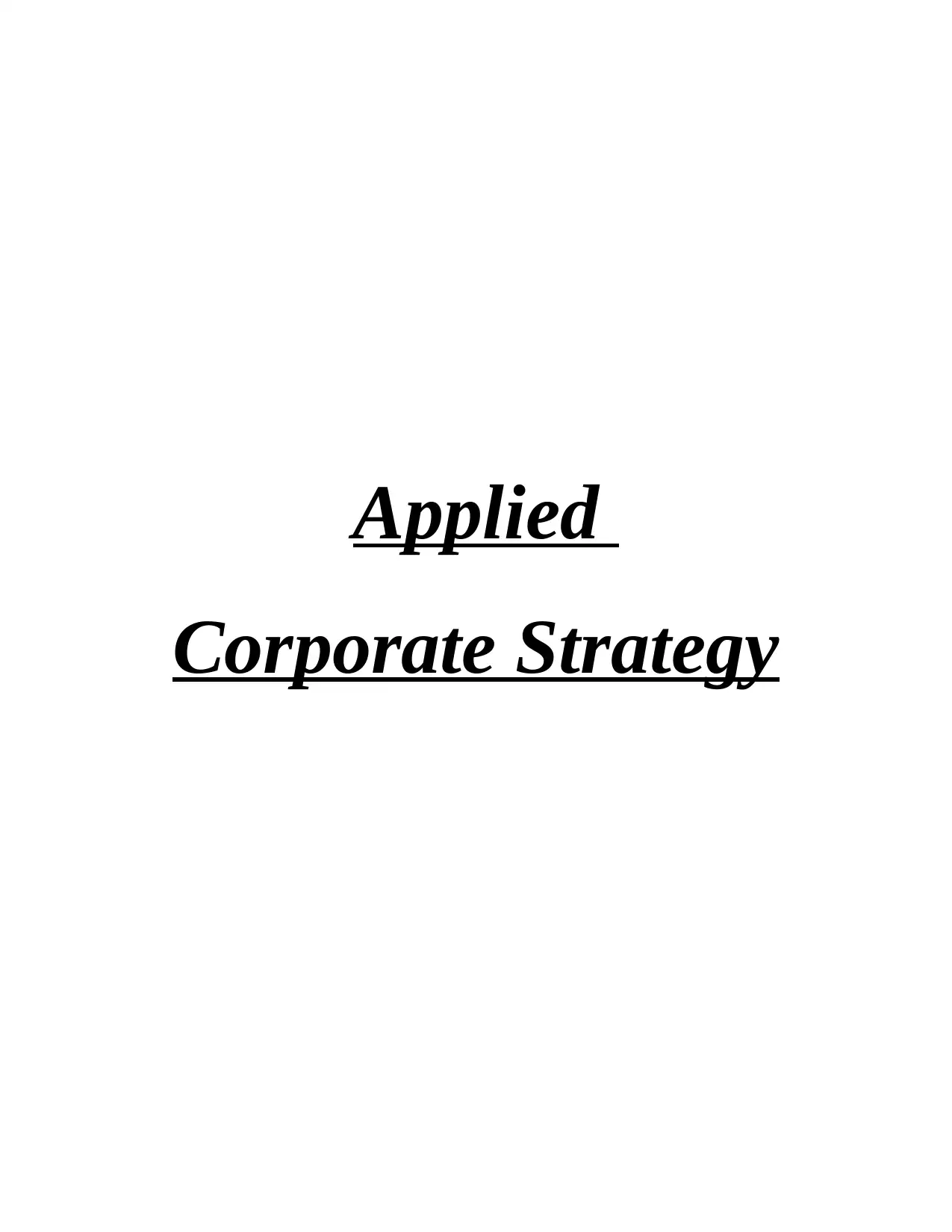
Applied
Corporate Strategy
Corporate Strategy
Secure Best Marks with AI Grader
Need help grading? Try our AI Grader for instant feedback on your assignments.
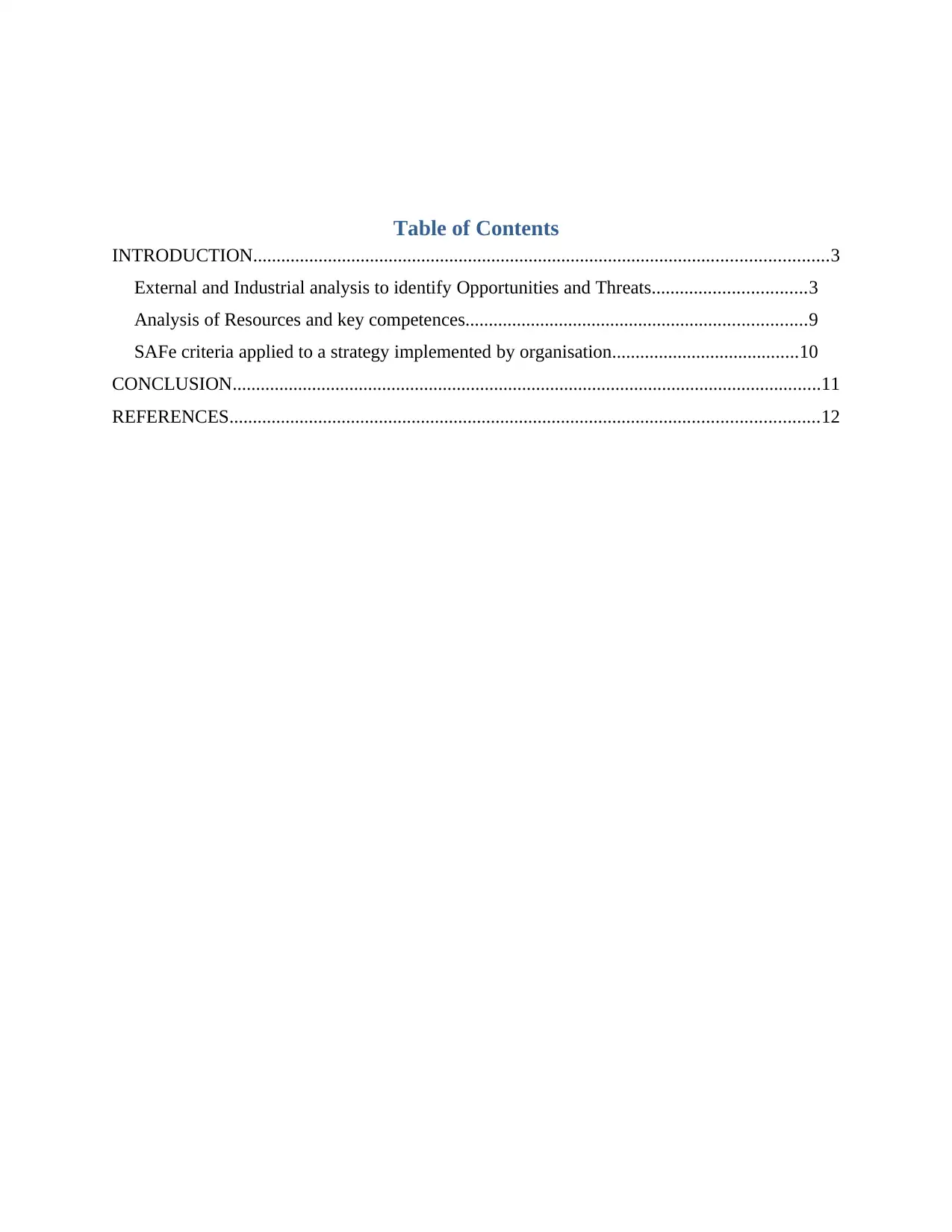
Table of Contents
INTRODUCTION...........................................................................................................................3
External and Industrial analysis to identify Opportunities and Threats.................................3
Analysis of Resources and key competences.........................................................................9
SAFe criteria applied to a strategy implemented by organisation........................................10
CONCLUSION..............................................................................................................................11
REFERENCES..............................................................................................................................12
INTRODUCTION...........................................................................................................................3
External and Industrial analysis to identify Opportunities and Threats.................................3
Analysis of Resources and key competences.........................................................................9
SAFe criteria applied to a strategy implemented by organisation........................................10
CONCLUSION..............................................................................................................................11
REFERENCES..............................................................................................................................12
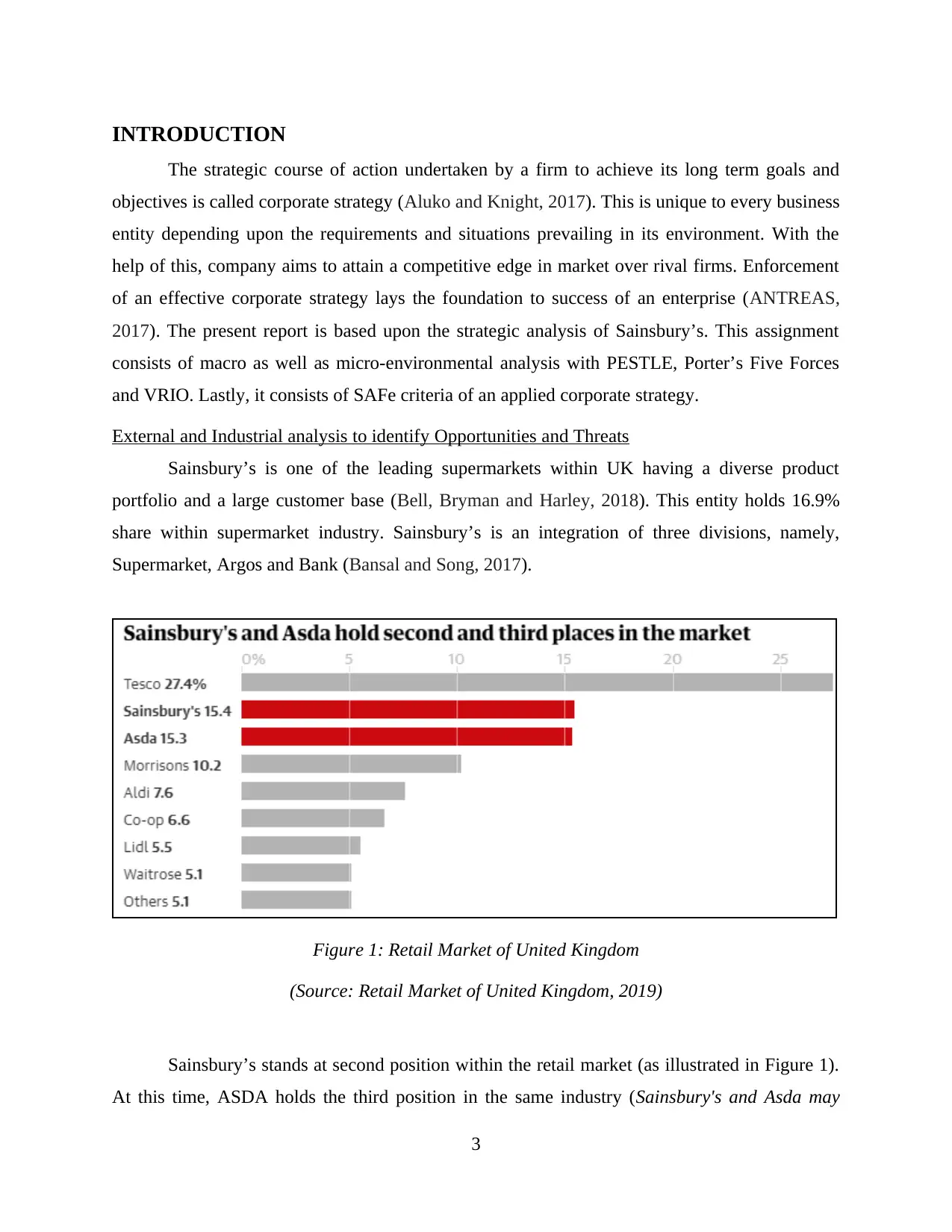
INTRODUCTION
The strategic course of action undertaken by a firm to achieve its long term goals and
objectives is called corporate strategy (Aluko and Knight, 2017). This is unique to every business
entity depending upon the requirements and situations prevailing in its environment. With the
help of this, company aims to attain a competitive edge in market over rival firms. Enforcement
of an effective corporate strategy lays the foundation to success of an enterprise (ANTREAS,
2017). The present report is based upon the strategic analysis of Sainsbury’s. This assignment
consists of macro as well as micro-environmental analysis with PESTLE, Porter’s Five Forces
and VRIO. Lastly, it consists of SAFe criteria of an applied corporate strategy.
External and Industrial analysis to identify Opportunities and Threats
Sainsbury’s is one of the leading supermarkets within UK having a diverse product
portfolio and a large customer base (Bell, Bryman and Harley, 2018). This entity holds 16.9%
share within supermarket industry. Sainsbury’s is an integration of three divisions, namely,
Supermarket, Argos and Bank (Bansal and Song, 2017).
Figure 1: Retail Market of United Kingdom
(Source: Retail Market of United Kingdom, 2019)
Sainsbury’s stands at second position within the retail market (as illustrated in Figure 1).
At this time, ASDA holds the third position in the same industry (Sainsbury's and Asda may
3
The strategic course of action undertaken by a firm to achieve its long term goals and
objectives is called corporate strategy (Aluko and Knight, 2017). This is unique to every business
entity depending upon the requirements and situations prevailing in its environment. With the
help of this, company aims to attain a competitive edge in market over rival firms. Enforcement
of an effective corporate strategy lays the foundation to success of an enterprise (ANTREAS,
2017). The present report is based upon the strategic analysis of Sainsbury’s. This assignment
consists of macro as well as micro-environmental analysis with PESTLE, Porter’s Five Forces
and VRIO. Lastly, it consists of SAFe criteria of an applied corporate strategy.
External and Industrial analysis to identify Opportunities and Threats
Sainsbury’s is one of the leading supermarkets within UK having a diverse product
portfolio and a large customer base (Bell, Bryman and Harley, 2018). This entity holds 16.9%
share within supermarket industry. Sainsbury’s is an integration of three divisions, namely,
Supermarket, Argos and Bank (Bansal and Song, 2017).
Figure 1: Retail Market of United Kingdom
(Source: Retail Market of United Kingdom, 2019)
Sainsbury’s stands at second position within the retail market (as illustrated in Figure 1).
At this time, ASDA holds the third position in the same industry (Sainsbury's and Asda may
3
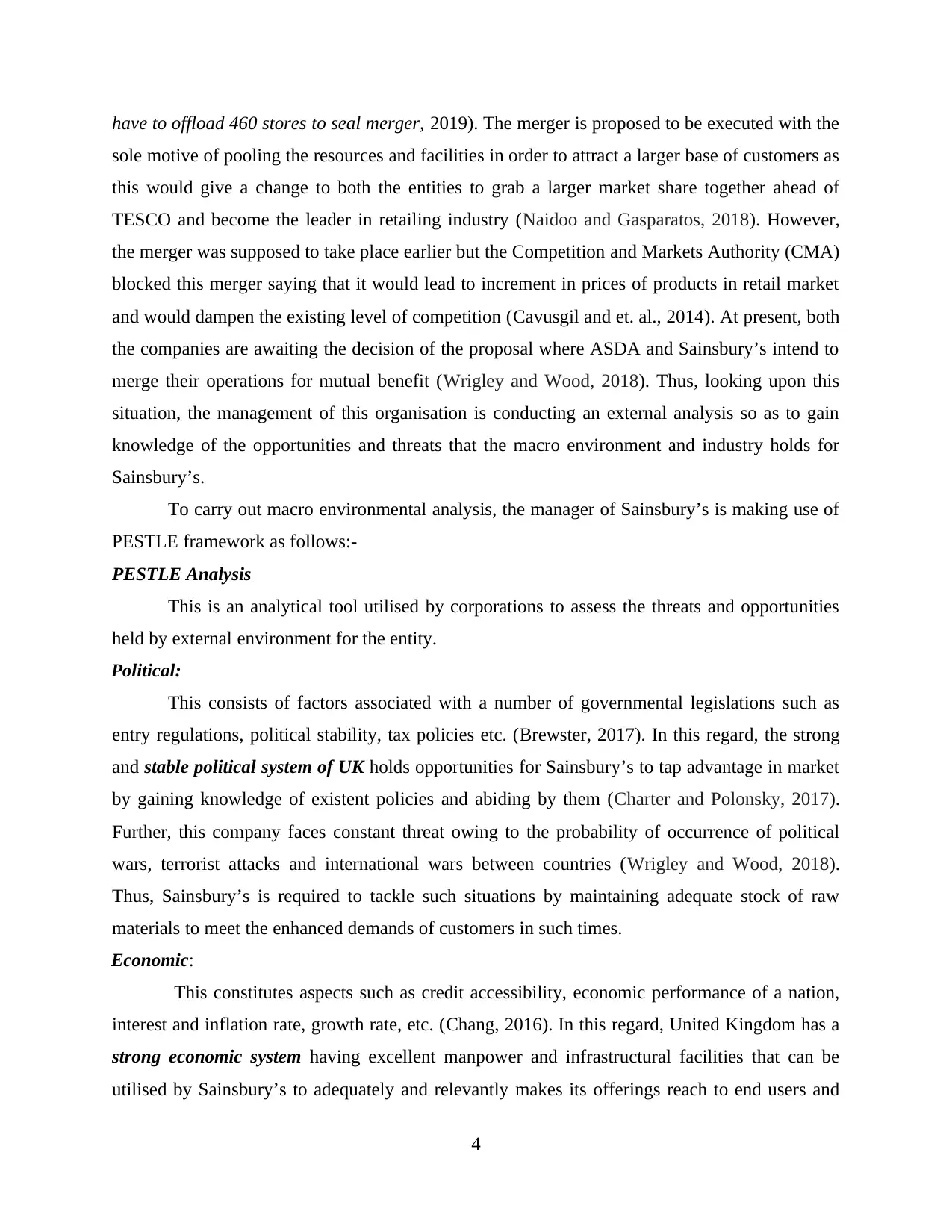
have to offload 460 stores to seal merger, 2019). The merger is proposed to be executed with the
sole motive of pooling the resources and facilities in order to attract a larger base of customers as
this would give a change to both the entities to grab a larger market share together ahead of
TESCO and become the leader in retailing industry (Naidoo and Gasparatos, 2018). However,
the merger was supposed to take place earlier but the Competition and Markets Authority (CMA)
blocked this merger saying that it would lead to increment in prices of products in retail market
and would dampen the existing level of competition (Cavusgil and et. al., 2014). At present, both
the companies are awaiting the decision of the proposal where ASDA and Sainsbury’s intend to
merge their operations for mutual benefit (Wrigley and Wood, 2018). Thus, looking upon this
situation, the management of this organisation is conducting an external analysis so as to gain
knowledge of the opportunities and threats that the macro environment and industry holds for
Sainsbury’s.
To carry out macro environmental analysis, the manager of Sainsbury’s is making use of
PESTLE framework as follows:-
PESTLE Analysis
This is an analytical tool utilised by corporations to assess the threats and opportunities
held by external environment for the entity.
Political:
This consists of factors associated with a number of governmental legislations such as
entry regulations, political stability, tax policies etc. (Brewster, 2017). In this regard, the strong
and stable political system of UK holds opportunities for Sainsbury’s to tap advantage in market
by gaining knowledge of existent policies and abiding by them (Charter and Polonsky, 2017).
Further, this company faces constant threat owing to the probability of occurrence of political
wars, terrorist attacks and international wars between countries (Wrigley and Wood, 2018).
Thus, Sainsbury’s is required to tackle such situations by maintaining adequate stock of raw
materials to meet the enhanced demands of customers in such times.
Economic:
This constitutes aspects such as credit accessibility, economic performance of a nation,
interest and inflation rate, growth rate, etc. (Chang, 2016). In this regard, United Kingdom has a
strong economic system having excellent manpower and infrastructural facilities that can be
utilised by Sainsbury’s to adequately and relevantly makes its offerings reach to end users and
4
sole motive of pooling the resources and facilities in order to attract a larger base of customers as
this would give a change to both the entities to grab a larger market share together ahead of
TESCO and become the leader in retailing industry (Naidoo and Gasparatos, 2018). However,
the merger was supposed to take place earlier but the Competition and Markets Authority (CMA)
blocked this merger saying that it would lead to increment in prices of products in retail market
and would dampen the existing level of competition (Cavusgil and et. al., 2014). At present, both
the companies are awaiting the decision of the proposal where ASDA and Sainsbury’s intend to
merge their operations for mutual benefit (Wrigley and Wood, 2018). Thus, looking upon this
situation, the management of this organisation is conducting an external analysis so as to gain
knowledge of the opportunities and threats that the macro environment and industry holds for
Sainsbury’s.
To carry out macro environmental analysis, the manager of Sainsbury’s is making use of
PESTLE framework as follows:-
PESTLE Analysis
This is an analytical tool utilised by corporations to assess the threats and opportunities
held by external environment for the entity.
Political:
This consists of factors associated with a number of governmental legislations such as
entry regulations, political stability, tax policies etc. (Brewster, 2017). In this regard, the strong
and stable political system of UK holds opportunities for Sainsbury’s to tap advantage in market
by gaining knowledge of existent policies and abiding by them (Charter and Polonsky, 2017).
Further, this company faces constant threat owing to the probability of occurrence of political
wars, terrorist attacks and international wars between countries (Wrigley and Wood, 2018).
Thus, Sainsbury’s is required to tackle such situations by maintaining adequate stock of raw
materials to meet the enhanced demands of customers in such times.
Economic:
This constitutes aspects such as credit accessibility, economic performance of a nation,
interest and inflation rate, growth rate, etc. (Chang, 2016). In this regard, United Kingdom has a
strong economic system having excellent manpower and infrastructural facilities that can be
utilised by Sainsbury’s to adequately and relevantly makes its offerings reach to end users and
4
Secure Best Marks with AI Grader
Need help grading? Try our AI Grader for instant feedback on your assignments.

derive maximum satisfaction from them. However, a state of recession may create difficulties for
company to cater to the price level demands of people (Chen and Jermias, 2014). To deal with,
Sainsbury’s can lower its prices, thus, enabling the customers despite lowered purchasing power
(Quader and Sohel, 2018).
Social:
This includes the changes that take place in lifestyles, needs, demands and living
standards of people that cause shift in demand for offerings of an entity (Du and et. al., 2013). In
this regard, Sainsbury’s has been a company that carries out extensive market research in order
to effectively fulfil the demands and expectations of people prevailing within market place. This
helps in positively influencing the buying behaviours of customers (Davies, 2016). However,
there is always a threat of introduction of a more trending and low cost product by rival firm
that meet the demand placed by consumers in an effective manner.
Technological:
This consists of the shifts that take place in technology and systems used by corporations
within market place with the passage of time (Engert and Baumgartner, 2016). Sainsbury’s owes
its second position within the retail market of United Kingdom to the technological processes
employed by the organisation to satisfy the customers effectively and consequently, enhance its
sales (He and Balmer, 2017). However, technological advancements can be brought by rivals of
this organisation such as LIDL, ALDI, TESCO and Marks & Spencer also (Goffee and Scase,
2015). This presents threat to the sustainability and market positioning of organisation and thus
needs to be taken into due consideration by Sainsbury’s.
Legal:
Several laws exist for the companies operating within retail market, such as employment,
health and safety, import and export regulations, patents violation etc. (Klettner, Clarke and
Boersma, 2014). Sainsbury’s abide by all necessary retail and environmental laws in order to
avoid any sort of legal adversities. Further, this organisation enforces a strict corporate culture
where breach of law is not tolerated and the guilty is dismissed from the company instantly
(Jocovic, and et. al., 2014). In the year 2010, Sainsbury’s was dragged to the doors of court for
being involved in the practice of over packaging. This led to huge penalty being imposed upon
the company (Sainsbury's taken to court over excess packaging, 2019). This instance brought
5
company to cater to the price level demands of people (Chen and Jermias, 2014). To deal with,
Sainsbury’s can lower its prices, thus, enabling the customers despite lowered purchasing power
(Quader and Sohel, 2018).
Social:
This includes the changes that take place in lifestyles, needs, demands and living
standards of people that cause shift in demand for offerings of an entity (Du and et. al., 2013). In
this regard, Sainsbury’s has been a company that carries out extensive market research in order
to effectively fulfil the demands and expectations of people prevailing within market place. This
helps in positively influencing the buying behaviours of customers (Davies, 2016). However,
there is always a threat of introduction of a more trending and low cost product by rival firm
that meet the demand placed by consumers in an effective manner.
Technological:
This consists of the shifts that take place in technology and systems used by corporations
within market place with the passage of time (Engert and Baumgartner, 2016). Sainsbury’s owes
its second position within the retail market of United Kingdom to the technological processes
employed by the organisation to satisfy the customers effectively and consequently, enhance its
sales (He and Balmer, 2017). However, technological advancements can be brought by rivals of
this organisation such as LIDL, ALDI, TESCO and Marks & Spencer also (Goffee and Scase,
2015). This presents threat to the sustainability and market positioning of organisation and thus
needs to be taken into due consideration by Sainsbury’s.
Legal:
Several laws exist for the companies operating within retail market, such as employment,
health and safety, import and export regulations, patents violation etc. (Klettner, Clarke and
Boersma, 2014). Sainsbury’s abide by all necessary retail and environmental laws in order to
avoid any sort of legal adversities. Further, this organisation enforces a strict corporate culture
where breach of law is not tolerated and the guilty is dismissed from the company instantly
(Jocovic, and et. al., 2014). In the year 2010, Sainsbury’s was dragged to the doors of court for
being involved in the practice of over packaging. This led to huge penalty being imposed upon
the company (Sainsbury's taken to court over excess packaging, 2019). This instance brought
5
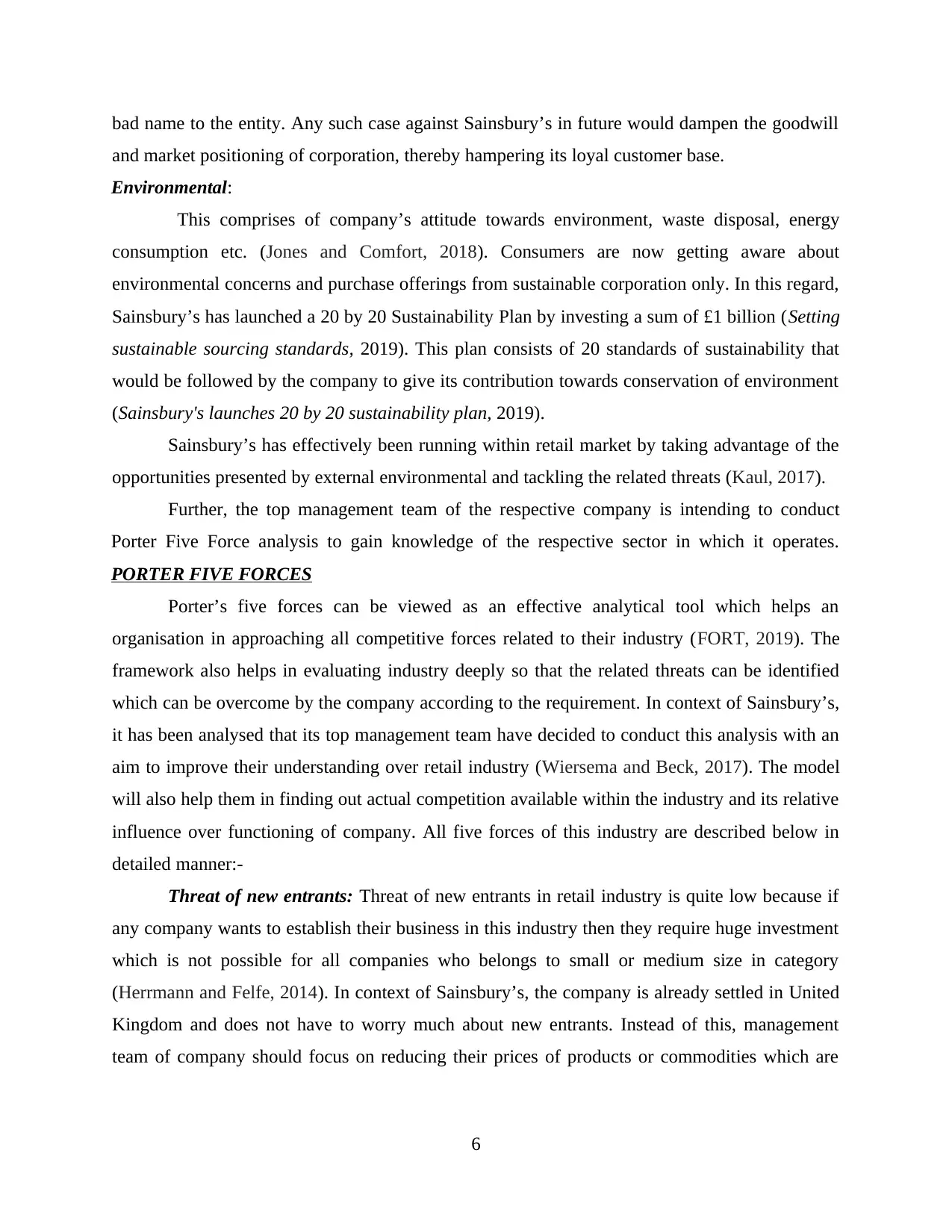
bad name to the entity. Any such case against Sainsbury’s in future would dampen the goodwill
and market positioning of corporation, thereby hampering its loyal customer base.
Environmental:
This comprises of company’s attitude towards environment, waste disposal, energy
consumption etc. (Jones and Comfort, 2018). Consumers are now getting aware about
environmental concerns and purchase offerings from sustainable corporation only. In this regard,
Sainsbury’s has launched a 20 by 20 Sustainability Plan by investing a sum of £1 billion (Setting
sustainable sourcing standards, 2019). This plan consists of 20 standards of sustainability that
would be followed by the company to give its contribution towards conservation of environment
(Sainsbury's launches 20 by 20 sustainability plan, 2019).
Sainsbury’s has effectively been running within retail market by taking advantage of the
opportunities presented by external environmental and tackling the related threats (Kaul, 2017).
Further, the top management team of the respective company is intending to conduct
Porter Five Force analysis to gain knowledge of the respective sector in which it operates.
PORTER FIVE FORCES
Porter’s five forces can be viewed as an effective analytical tool which helps an
organisation in approaching all competitive forces related to their industry (FORT, 2019). The
framework also helps in evaluating industry deeply so that the related threats can be identified
which can be overcome by the company according to the requirement. In context of Sainsbury’s,
it has been analysed that its top management team have decided to conduct this analysis with an
aim to improve their understanding over retail industry (Wiersema and Beck, 2017). The model
will also help them in finding out actual competition available within the industry and its relative
influence over functioning of company. All five forces of this industry are described below in
detailed manner:-
Threat of new entrants: Threat of new entrants in retail industry is quite low because if
any company wants to establish their business in this industry then they require huge investment
which is not possible for all companies who belongs to small or medium size in category
(Herrmann and Felfe, 2014). In context of Sainsbury’s, the company is already settled in United
Kingdom and does not have to worry much about new entrants. Instead of this, management
team of company should focus on reducing their prices of products or commodities which are
6
and market positioning of corporation, thereby hampering its loyal customer base.
Environmental:
This comprises of company’s attitude towards environment, waste disposal, energy
consumption etc. (Jones and Comfort, 2018). Consumers are now getting aware about
environmental concerns and purchase offerings from sustainable corporation only. In this regard,
Sainsbury’s has launched a 20 by 20 Sustainability Plan by investing a sum of £1 billion (Setting
sustainable sourcing standards, 2019). This plan consists of 20 standards of sustainability that
would be followed by the company to give its contribution towards conservation of environment
(Sainsbury's launches 20 by 20 sustainability plan, 2019).
Sainsbury’s has effectively been running within retail market by taking advantage of the
opportunities presented by external environmental and tackling the related threats (Kaul, 2017).
Further, the top management team of the respective company is intending to conduct
Porter Five Force analysis to gain knowledge of the respective sector in which it operates.
PORTER FIVE FORCES
Porter’s five forces can be viewed as an effective analytical tool which helps an
organisation in approaching all competitive forces related to their industry (FORT, 2019). The
framework also helps in evaluating industry deeply so that the related threats can be identified
which can be overcome by the company according to the requirement. In context of Sainsbury’s,
it has been analysed that its top management team have decided to conduct this analysis with an
aim to improve their understanding over retail industry (Wiersema and Beck, 2017). The model
will also help them in finding out actual competition available within the industry and its relative
influence over functioning of company. All five forces of this industry are described below in
detailed manner:-
Threat of new entrants: Threat of new entrants in retail industry is quite low because if
any company wants to establish their business in this industry then they require huge investment
which is not possible for all companies who belongs to small or medium size in category
(Herrmann and Felfe, 2014). In context of Sainsbury’s, the company is already settled in United
Kingdom and does not have to worry much about new entrants. Instead of this, management
team of company should focus on reducing their prices of products or commodities which are
6

being offered to customers in their stores (Habbash, 2017). This will help out in sustaining
customers longer in the company.
Threat of substitutes: For retail industry, threat of substitutes is relatively high. This is
because, it has been seen that there are numerous of companies who emphasizes on finding out
alternative product or method through which they can compete companies belonging to retail
industry and grab attention of customers (Gnan, Montemerlo and Huse, 2015). In context of
Sainsbury’s, it is essential for this company to conduct an effective market research so that they
can get aware of actual demand and supply of customers. This research will allow company in
developing actual products of customers wants (Jeston, 2014). As a result, the company directly
gives reason to customers to stay loyal with them for longer period of time as the company is
caring about their needs and requirements and accordingly introducing products for the same
according to the actual requirement of customers (Quader and Sohel, 2018).
Bargaining power of customers: For retail industry, bargaining power of buyer is quite
high as customers are the only one who decides that which company will sustain in the industry
which one should wind up their business (Elfarmawi, 2019). It has also been seen that there are
numerous of companies within the retail industry who offers similar kind of products and
services. Because, if in case customers finds out any low price of same quality in competitors
outlet then they will definitely switch to another retail stores for their requirement (Marsh, 2013).
Therefore, in order to sustain longer in the industry it is essential for Sainsbury’s to focus on
delivering best products and services to customers at lower prices for sustaining them loyal
towards the company (Quader and Sohel, 2018).
Bargaining power of suppliers: Bargaining power of supplier in retail industry,
especially for Sainsbury’s is low (Lockyer, 2018). This is because, there are numerous of
suppliers who focuses getting contracts with large companies like Sainsbury’s so that they can
get huge orders from them which ultimately provides them high range of business. This thought
ultimately influences suppliers to agree on the quotation given by the company for raw materials
(Laudon and Traver, 2016). If these suppliers focus on intense bargaining then they might lose
contract of Sainsbury’s as the company can directly switch to another supplier who agreed for
the same commodity at low price (Lam and O'Higgins, 2012). Thus, suppliers easily accept the
quotation for maintaining their relationships with the brand for long term benefits.
7
customers longer in the company.
Threat of substitutes: For retail industry, threat of substitutes is relatively high. This is
because, it has been seen that there are numerous of companies who emphasizes on finding out
alternative product or method through which they can compete companies belonging to retail
industry and grab attention of customers (Gnan, Montemerlo and Huse, 2015). In context of
Sainsbury’s, it is essential for this company to conduct an effective market research so that they
can get aware of actual demand and supply of customers. This research will allow company in
developing actual products of customers wants (Jeston, 2014). As a result, the company directly
gives reason to customers to stay loyal with them for longer period of time as the company is
caring about their needs and requirements and accordingly introducing products for the same
according to the actual requirement of customers (Quader and Sohel, 2018).
Bargaining power of customers: For retail industry, bargaining power of buyer is quite
high as customers are the only one who decides that which company will sustain in the industry
which one should wind up their business (Elfarmawi, 2019). It has also been seen that there are
numerous of companies within the retail industry who offers similar kind of products and
services. Because, if in case customers finds out any low price of same quality in competitors
outlet then they will definitely switch to another retail stores for their requirement (Marsh, 2013).
Therefore, in order to sustain longer in the industry it is essential for Sainsbury’s to focus on
delivering best products and services to customers at lower prices for sustaining them loyal
towards the company (Quader and Sohel, 2018).
Bargaining power of suppliers: Bargaining power of supplier in retail industry,
especially for Sainsbury’s is low (Lockyer, 2018). This is because, there are numerous of
suppliers who focuses getting contracts with large companies like Sainsbury’s so that they can
get huge orders from them which ultimately provides them high range of business. This thought
ultimately influences suppliers to agree on the quotation given by the company for raw materials
(Laudon and Traver, 2016). If these suppliers focus on intense bargaining then they might lose
contract of Sainsbury’s as the company can directly switch to another supplier who agreed for
the same commodity at low price (Lam and O'Higgins, 2012). Thus, suppliers easily accept the
quotation for maintaining their relationships with the brand for long term benefits.
7
Paraphrase This Document
Need a fresh take? Get an instant paraphrase of this document with our AI Paraphraser
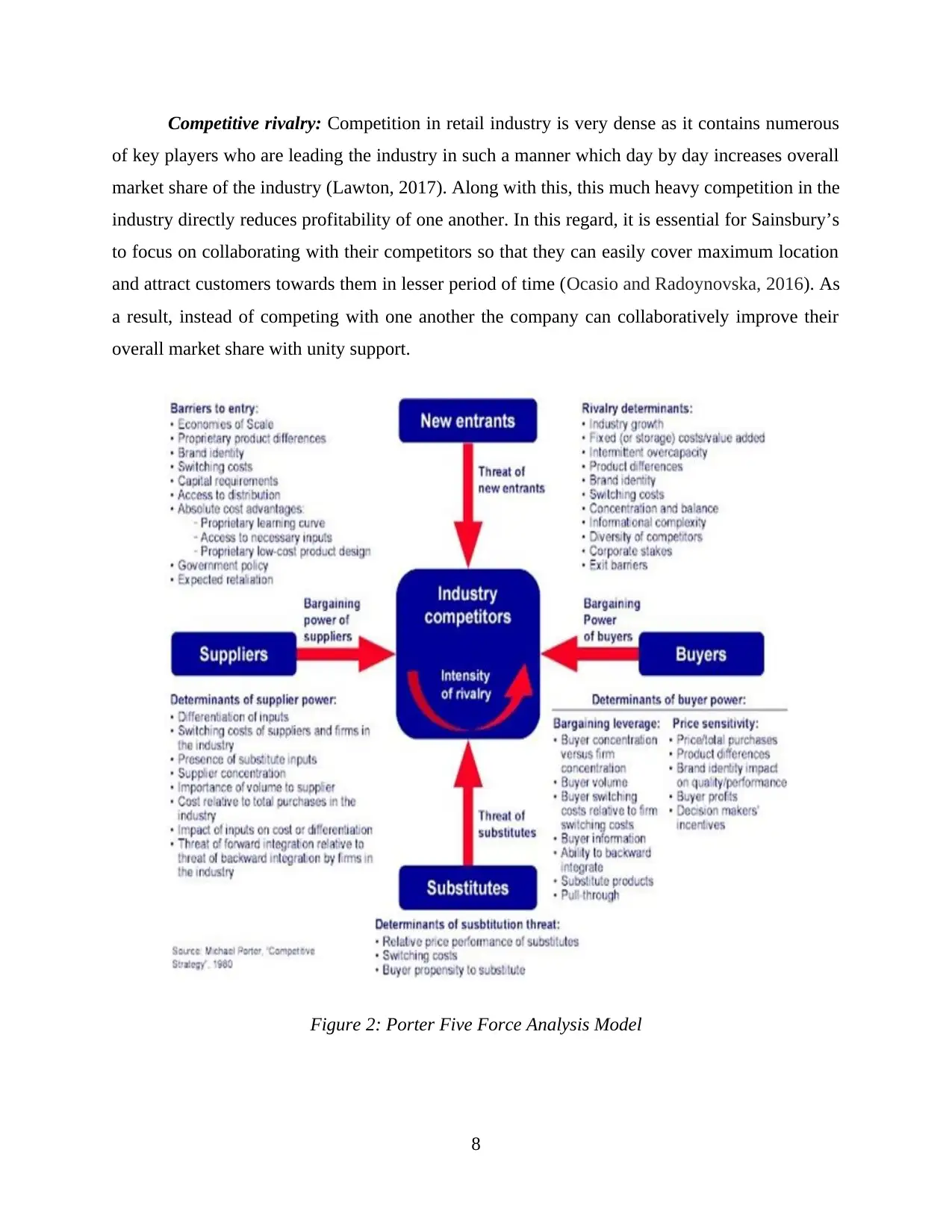
Competitive rivalry: Competition in retail industry is very dense as it contains numerous
of key players who are leading the industry in such a manner which day by day increases overall
market share of the industry (Lawton, 2017). Along with this, this much heavy competition in the
industry directly reduces profitability of one another. In this regard, it is essential for Sainsbury’s
to focus on collaborating with their competitors so that they can easily cover maximum location
and attract customers towards them in lesser period of time (Ocasio and Radoynovska, 2016). As
a result, instead of competing with one another the company can collaboratively improve their
overall market share with unity support.
Figure 2: Porter Five Force Analysis Model
8
of key players who are leading the industry in such a manner which day by day increases overall
market share of the industry (Lawton, 2017). Along with this, this much heavy competition in the
industry directly reduces profitability of one another. In this regard, it is essential for Sainsbury’s
to focus on collaborating with their competitors so that they can easily cover maximum location
and attract customers towards them in lesser period of time (Ocasio and Radoynovska, 2016). As
a result, instead of competing with one another the company can collaboratively improve their
overall market share with unity support.
Figure 2: Porter Five Force Analysis Model
8
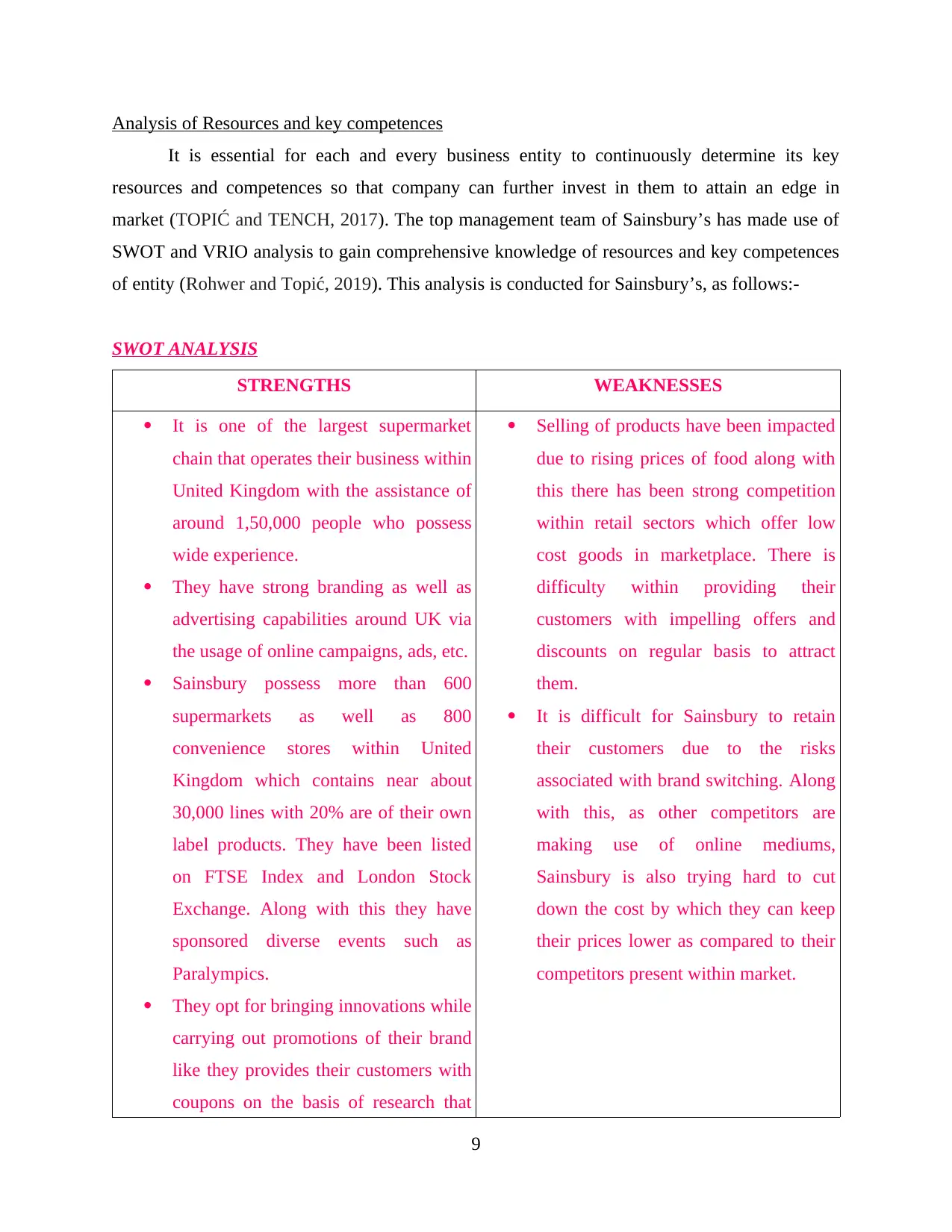
Analysis of Resources and key competences
It is essential for each and every business entity to continuously determine its key
resources and competences so that company can further invest in them to attain an edge in
market (TOPIĆ and TENCH, 2017). The top management team of Sainsbury’s has made use of
SWOT and VRIO analysis to gain comprehensive knowledge of resources and key competences
of entity (Rohwer and Topić, 2019). This analysis is conducted for Sainsbury’s, as follows:-
SWOT ANALYSIS
STRENGTHS WEAKNESSES
It is one of the largest supermarket
chain that operates their business within
United Kingdom with the assistance of
around 1,50,000 people who possess
wide experience.
They have strong branding as well as
advertising capabilities around UK via
the usage of online campaigns, ads, etc.
Sainsbury possess more than 600
supermarkets as well as 800
convenience stores within United
Kingdom which contains near about
30,000 lines with 20% are of their own
label products. They have been listed
on FTSE Index and London Stock
Exchange. Along with this they have
sponsored diverse events such as
Paralympics.
They opt for bringing innovations while
carrying out promotions of their brand
like they provides their customers with
coupons on the basis of research that
Selling of products have been impacted
due to rising prices of food along with
this there has been strong competition
within retail sectors which offer low
cost goods in marketplace. There is
difficulty within providing their
customers with impelling offers and
discounts on regular basis to attract
them.
It is difficult for Sainsbury to retain
their customers due to the risks
associated with brand switching. Along
with this, as other competitors are
making use of online mediums,
Sainsbury is also trying hard to cut
down the cost by which they can keep
their prices lower as compared to their
competitors present within market.
9
It is essential for each and every business entity to continuously determine its key
resources and competences so that company can further invest in them to attain an edge in
market (TOPIĆ and TENCH, 2017). The top management team of Sainsbury’s has made use of
SWOT and VRIO analysis to gain comprehensive knowledge of resources and key competences
of entity (Rohwer and Topić, 2019). This analysis is conducted for Sainsbury’s, as follows:-
SWOT ANALYSIS
STRENGTHS WEAKNESSES
It is one of the largest supermarket
chain that operates their business within
United Kingdom with the assistance of
around 1,50,000 people who possess
wide experience.
They have strong branding as well as
advertising capabilities around UK via
the usage of online campaigns, ads, etc.
Sainsbury possess more than 600
supermarkets as well as 800
convenience stores within United
Kingdom which contains near about
30,000 lines with 20% are of their own
label products. They have been listed
on FTSE Index and London Stock
Exchange. Along with this they have
sponsored diverse events such as
Paralympics.
They opt for bringing innovations while
carrying out promotions of their brand
like they provides their customers with
coupons on the basis of research that
Selling of products have been impacted
due to rising prices of food along with
this there has been strong competition
within retail sectors which offer low
cost goods in marketplace. There is
difficulty within providing their
customers with impelling offers and
discounts on regular basis to attract
them.
It is difficult for Sainsbury to retain
their customers due to the risks
associated with brand switching. Along
with this, as other competitors are
making use of online mediums,
Sainsbury is also trying hard to cut
down the cost by which they can keep
their prices lower as compared to their
competitors present within market.
9

has been carried out by them with
respect to buying behaviour of their
consumers and Sainsbury have been
compiled with Nectar Loyalty Card
Scheme.
TOWS ANALYSIS
SAINSBURY'S
STRENGTHS (S) WEAKNESSES (W)
Large and competent
Workforce
Large Chain of Stores
Strong Brand Image
Strong Advertising
Low cost products of
rivals
Brand Switching
OPPORTUNITIES (O)
Stable Political State
Effective economic
conditions
Technological
Advancements
Rising awareness
among consumers
THREATS (T) Introduction of low
cost goods by rivals
Changing Legal
regulations
VALUE CHAIN
PRIMARY
ACTIVITIES COMPETENCIES SUPPORTING
ACTIVITIES
COMPETITIVE
ADVANTAGE
Inbound
Logistics
Effective Warehousing Infrastructure High
Operations Company is having best effective
form of branch operations in context
with acquisition of human resources
HR Department Extremely high
10
respect to buying behaviour of their
consumers and Sainsbury have been
compiled with Nectar Loyalty Card
Scheme.
TOWS ANALYSIS
SAINSBURY'S
STRENGTHS (S) WEAKNESSES (W)
Large and competent
Workforce
Large Chain of Stores
Strong Brand Image
Strong Advertising
Low cost products of
rivals
Brand Switching
OPPORTUNITIES (O)
Stable Political State
Effective economic
conditions
Technological
Advancements
Rising awareness
among consumers
THREATS (T) Introduction of low
cost goods by rivals
Changing Legal
regulations
VALUE CHAIN
PRIMARY
ACTIVITIES COMPETENCIES SUPPORTING
ACTIVITIES
COMPETITIVE
ADVANTAGE
Inbound
Logistics
Effective Warehousing Infrastructure High
Operations Company is having best effective
form of branch operations in context
with acquisition of human resources
HR Department Extremely high
10
Secure Best Marks with AI Grader
Need help grading? Try our AI Grader for instant feedback on your assignments.
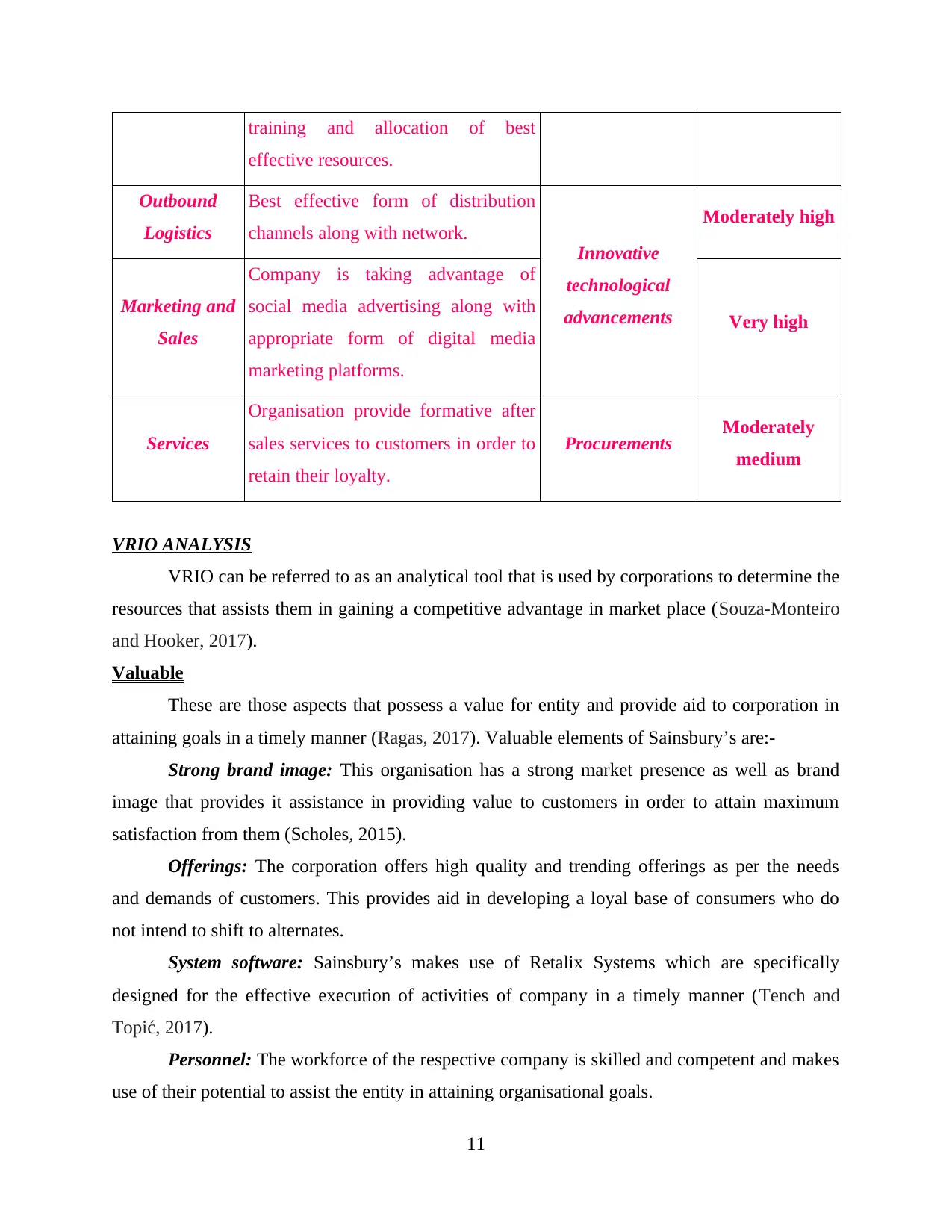
training and allocation of best
effective resources.
Outbound
Logistics
Best effective form of distribution
channels along with network.
Innovative
technological
advancements
Moderately high
Marketing and
Sales
Company is taking advantage of
social media advertising along with
appropriate form of digital media
marketing platforms.
Very high
Services
Organisation provide formative after
sales services to customers in order to
retain their loyalty.
Procurements Moderately
medium
VRIO ANALYSIS
VRIO can be referred to as an analytical tool that is used by corporations to determine the
resources that assists them in gaining a competitive advantage in market place (Souza-Monteiro
and Hooker, 2017).
Valuable
These are those aspects that possess a value for entity and provide aid to corporation in
attaining goals in a timely manner (Ragas, 2017). Valuable elements of Sainsbury’s are:-
Strong brand image: This organisation has a strong market presence as well as brand
image that provides it assistance in providing value to customers in order to attain maximum
satisfaction from them (Scholes, 2015).
Offerings: The corporation offers high quality and trending offerings as per the needs
and demands of customers. This provides aid in developing a loyal base of consumers who do
not intend to shift to alternates.
System software: Sainsbury’s makes use of Retalix Systems which are specifically
designed for the effective execution of activities of company in a timely manner (Tench and
Topić, 2017).
Personnel: The workforce of the respective company is skilled and competent and makes
use of their potential to assist the entity in attaining organisational goals.
11
effective resources.
Outbound
Logistics
Best effective form of distribution
channels along with network.
Innovative
technological
advancements
Moderately high
Marketing and
Sales
Company is taking advantage of
social media advertising along with
appropriate form of digital media
marketing platforms.
Very high
Services
Organisation provide formative after
sales services to customers in order to
retain their loyalty.
Procurements Moderately
medium
VRIO ANALYSIS
VRIO can be referred to as an analytical tool that is used by corporations to determine the
resources that assists them in gaining a competitive advantage in market place (Souza-Monteiro
and Hooker, 2017).
Valuable
These are those aspects that possess a value for entity and provide aid to corporation in
attaining goals in a timely manner (Ragas, 2017). Valuable elements of Sainsbury’s are:-
Strong brand image: This organisation has a strong market presence as well as brand
image that provides it assistance in providing value to customers in order to attain maximum
satisfaction from them (Scholes, 2015).
Offerings: The corporation offers high quality and trending offerings as per the needs
and demands of customers. This provides aid in developing a loyal base of consumers who do
not intend to shift to alternates.
System software: Sainsbury’s makes use of Retalix Systems which are specifically
designed for the effective execution of activities of company in a timely manner (Tench and
Topić, 2017).
Personnel: The workforce of the respective company is skilled and competent and makes
use of their potential to assist the entity in attaining organisational goals.
11
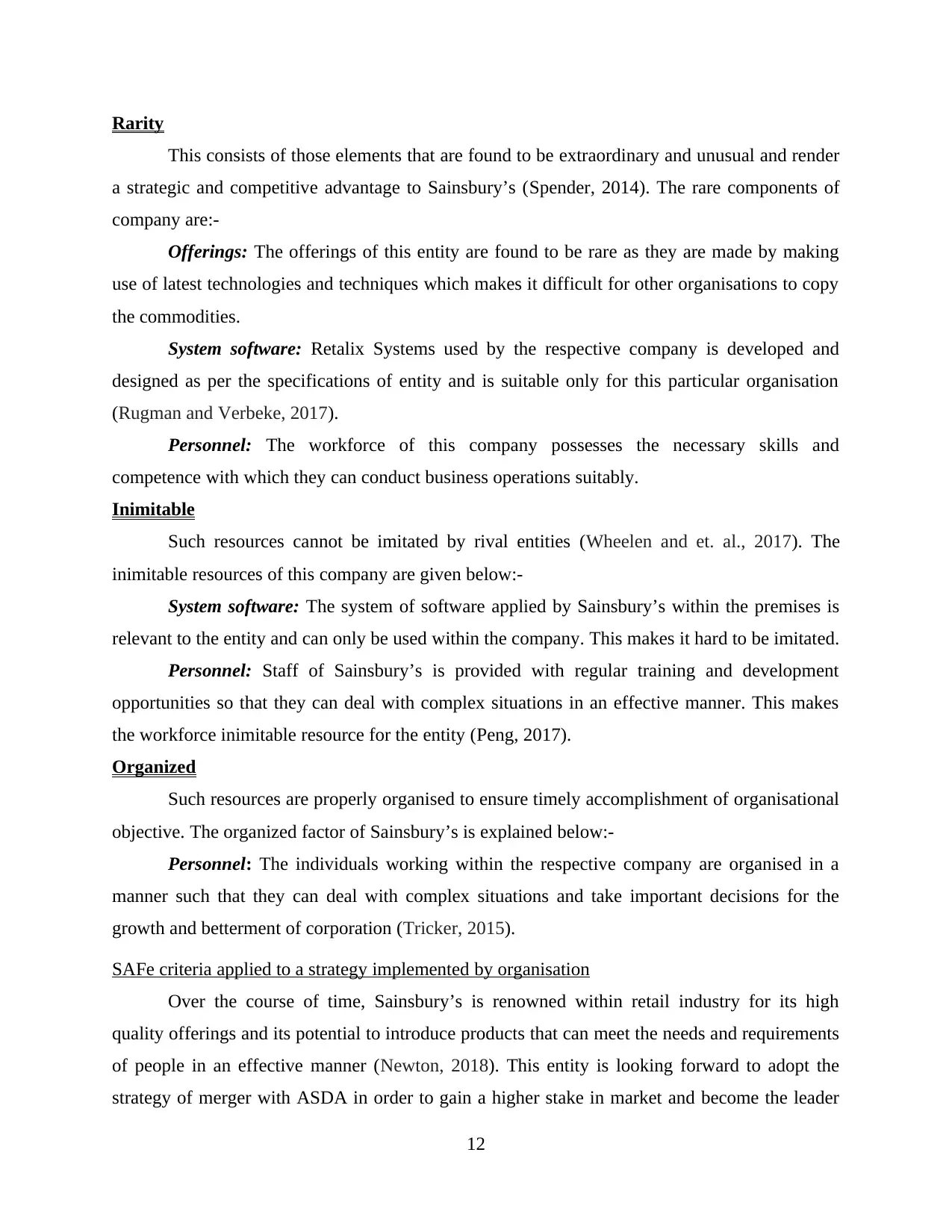
Rarity
This consists of those elements that are found to be extraordinary and unusual and render
a strategic and competitive advantage to Sainsbury’s (Spender, 2014). The rare components of
company are:-
Offerings: The offerings of this entity are found to be rare as they are made by making
use of latest technologies and techniques which makes it difficult for other organisations to copy
the commodities.
System software: Retalix Systems used by the respective company is developed and
designed as per the specifications of entity and is suitable only for this particular organisation
(Rugman and Verbeke, 2017).
Personnel: The workforce of this company possesses the necessary skills and
competence with which they can conduct business operations suitably.
Inimitable
Such resources cannot be imitated by rival entities (Wheelen and et. al., 2017). The
inimitable resources of this company are given below:-
System software: The system of software applied by Sainsbury’s within the premises is
relevant to the entity and can only be used within the company. This makes it hard to be imitated.
Personnel: Staff of Sainsbury’s is provided with regular training and development
opportunities so that they can deal with complex situations in an effective manner. This makes
the workforce inimitable resource for the entity (Peng, 2017).
Organized
Such resources are properly organised to ensure timely accomplishment of organisational
objective. The organized factor of Sainsbury’s is explained below:-
Personnel: The individuals working within the respective company are organised in a
manner such that they can deal with complex situations and take important decisions for the
growth and betterment of corporation (Tricker, 2015).
SAFe criteria applied to a strategy implemented by organisation
Over the course of time, Sainsbury’s is renowned within retail industry for its high
quality offerings and its potential to introduce products that can meet the needs and requirements
of people in an effective manner (Newton, 2018). This entity is looking forward to adopt the
strategy of merger with ASDA in order to gain a higher stake in market and become the leader
12
This consists of those elements that are found to be extraordinary and unusual and render
a strategic and competitive advantage to Sainsbury’s (Spender, 2014). The rare components of
company are:-
Offerings: The offerings of this entity are found to be rare as they are made by making
use of latest technologies and techniques which makes it difficult for other organisations to copy
the commodities.
System software: Retalix Systems used by the respective company is developed and
designed as per the specifications of entity and is suitable only for this particular organisation
(Rugman and Verbeke, 2017).
Personnel: The workforce of this company possesses the necessary skills and
competence with which they can conduct business operations suitably.
Inimitable
Such resources cannot be imitated by rival entities (Wheelen and et. al., 2017). The
inimitable resources of this company are given below:-
System software: The system of software applied by Sainsbury’s within the premises is
relevant to the entity and can only be used within the company. This makes it hard to be imitated.
Personnel: Staff of Sainsbury’s is provided with regular training and development
opportunities so that they can deal with complex situations in an effective manner. This makes
the workforce inimitable resource for the entity (Peng, 2017).
Organized
Such resources are properly organised to ensure timely accomplishment of organisational
objective. The organized factor of Sainsbury’s is explained below:-
Personnel: The individuals working within the respective company are organised in a
manner such that they can deal with complex situations and take important decisions for the
growth and betterment of corporation (Tricker, 2015).
SAFe criteria applied to a strategy implemented by organisation
Over the course of time, Sainsbury’s is renowned within retail industry for its high
quality offerings and its potential to introduce products that can meet the needs and requirements
of people in an effective manner (Newton, 2018). This entity is looking forward to adopt the
strategy of merger with ASDA in order to gain a higher stake in market and become the leader
12
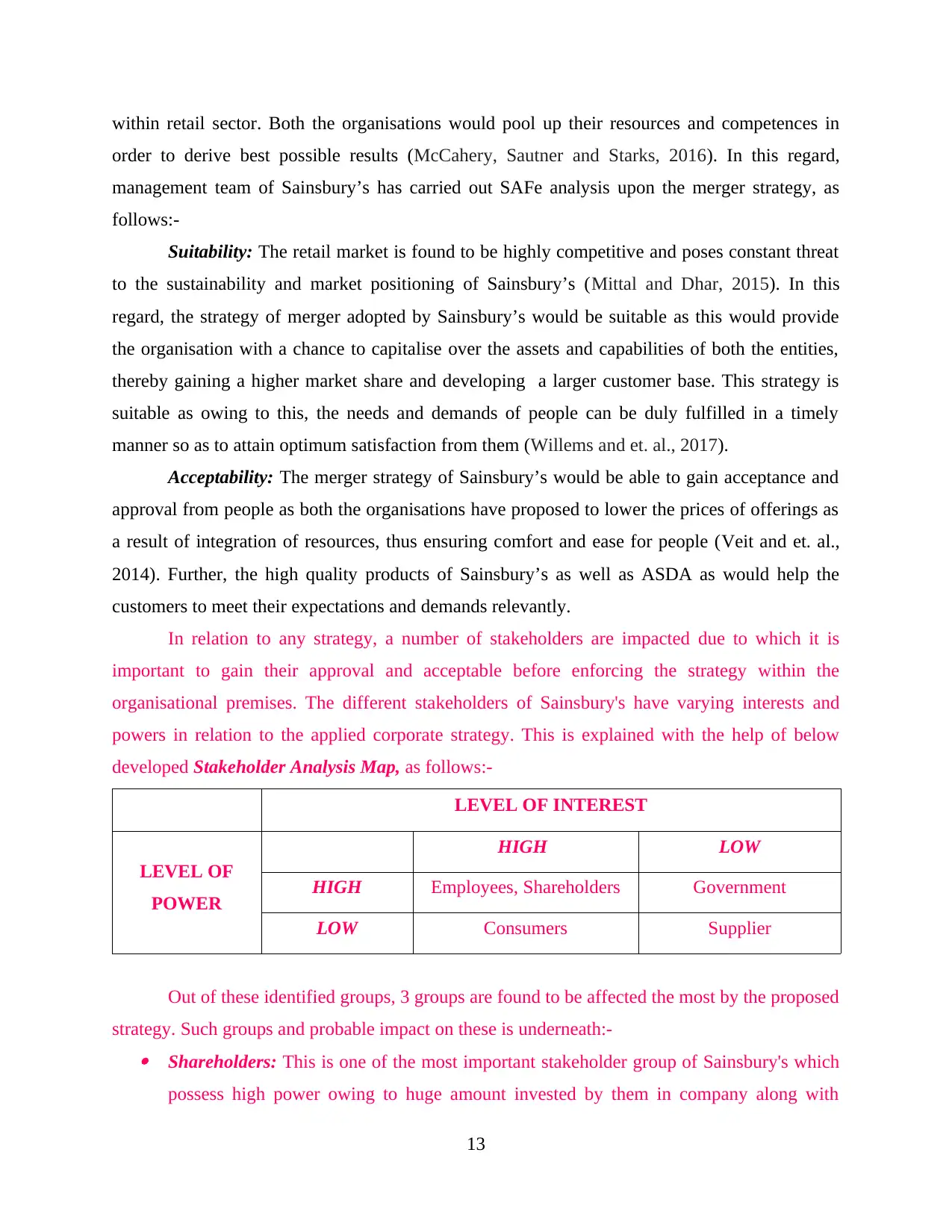
within retail sector. Both the organisations would pool up their resources and competences in
order to derive best possible results (McCahery, Sautner and Starks, 2016). In this regard,
management team of Sainsbury’s has carried out SAFe analysis upon the merger strategy, as
follows:-
Suitability: The retail market is found to be highly competitive and poses constant threat
to the sustainability and market positioning of Sainsbury’s (Mittal and Dhar, 2015). In this
regard, the strategy of merger adopted by Sainsbury’s would be suitable as this would provide
the organisation with a chance to capitalise over the assets and capabilities of both the entities,
thereby gaining a higher market share and developing a larger customer base. This strategy is
suitable as owing to this, the needs and demands of people can be duly fulfilled in a timely
manner so as to attain optimum satisfaction from them (Willems and et. al., 2017).
Acceptability: The merger strategy of Sainsbury’s would be able to gain acceptance and
approval from people as both the organisations have proposed to lower the prices of offerings as
a result of integration of resources, thus ensuring comfort and ease for people (Veit and et. al.,
2014). Further, the high quality products of Sainsbury’s as well as ASDA as would help the
customers to meet their expectations and demands relevantly.
In relation to any strategy, a number of stakeholders are impacted due to which it is
important to gain their approval and acceptable before enforcing the strategy within the
organisational premises. The different stakeholders of Sainsbury's have varying interests and
powers in relation to the applied corporate strategy. This is explained with the help of below
developed Stakeholder Analysis Map, as follows:-
LEVEL OF INTEREST
LEVEL OF
POWER
HIGH LOW
HIGH Employees, Shareholders Government
LOW Consumers Supplier
Out of these identified groups, 3 groups are found to be affected the most by the proposed
strategy. Such groups and probable impact on these is underneath:- Shareholders: This is one of the most important stakeholder group of Sainsbury's which
possess high power owing to huge amount invested by them in company along with
13
order to derive best possible results (McCahery, Sautner and Starks, 2016). In this regard,
management team of Sainsbury’s has carried out SAFe analysis upon the merger strategy, as
follows:-
Suitability: The retail market is found to be highly competitive and poses constant threat
to the sustainability and market positioning of Sainsbury’s (Mittal and Dhar, 2015). In this
regard, the strategy of merger adopted by Sainsbury’s would be suitable as this would provide
the organisation with a chance to capitalise over the assets and capabilities of both the entities,
thereby gaining a higher market share and developing a larger customer base. This strategy is
suitable as owing to this, the needs and demands of people can be duly fulfilled in a timely
manner so as to attain optimum satisfaction from them (Willems and et. al., 2017).
Acceptability: The merger strategy of Sainsbury’s would be able to gain acceptance and
approval from people as both the organisations have proposed to lower the prices of offerings as
a result of integration of resources, thus ensuring comfort and ease for people (Veit and et. al.,
2014). Further, the high quality products of Sainsbury’s as well as ASDA as would help the
customers to meet their expectations and demands relevantly.
In relation to any strategy, a number of stakeholders are impacted due to which it is
important to gain their approval and acceptable before enforcing the strategy within the
organisational premises. The different stakeholders of Sainsbury's have varying interests and
powers in relation to the applied corporate strategy. This is explained with the help of below
developed Stakeholder Analysis Map, as follows:-
LEVEL OF INTEREST
LEVEL OF
POWER
HIGH LOW
HIGH Employees, Shareholders Government
LOW Consumers Supplier
Out of these identified groups, 3 groups are found to be affected the most by the proposed
strategy. Such groups and probable impact on these is underneath:- Shareholders: This is one of the most important stakeholder group of Sainsbury's which
possess high power owing to huge amount invested by them in company along with
13
Paraphrase This Document
Need a fresh take? Get an instant paraphrase of this document with our AI Paraphraser
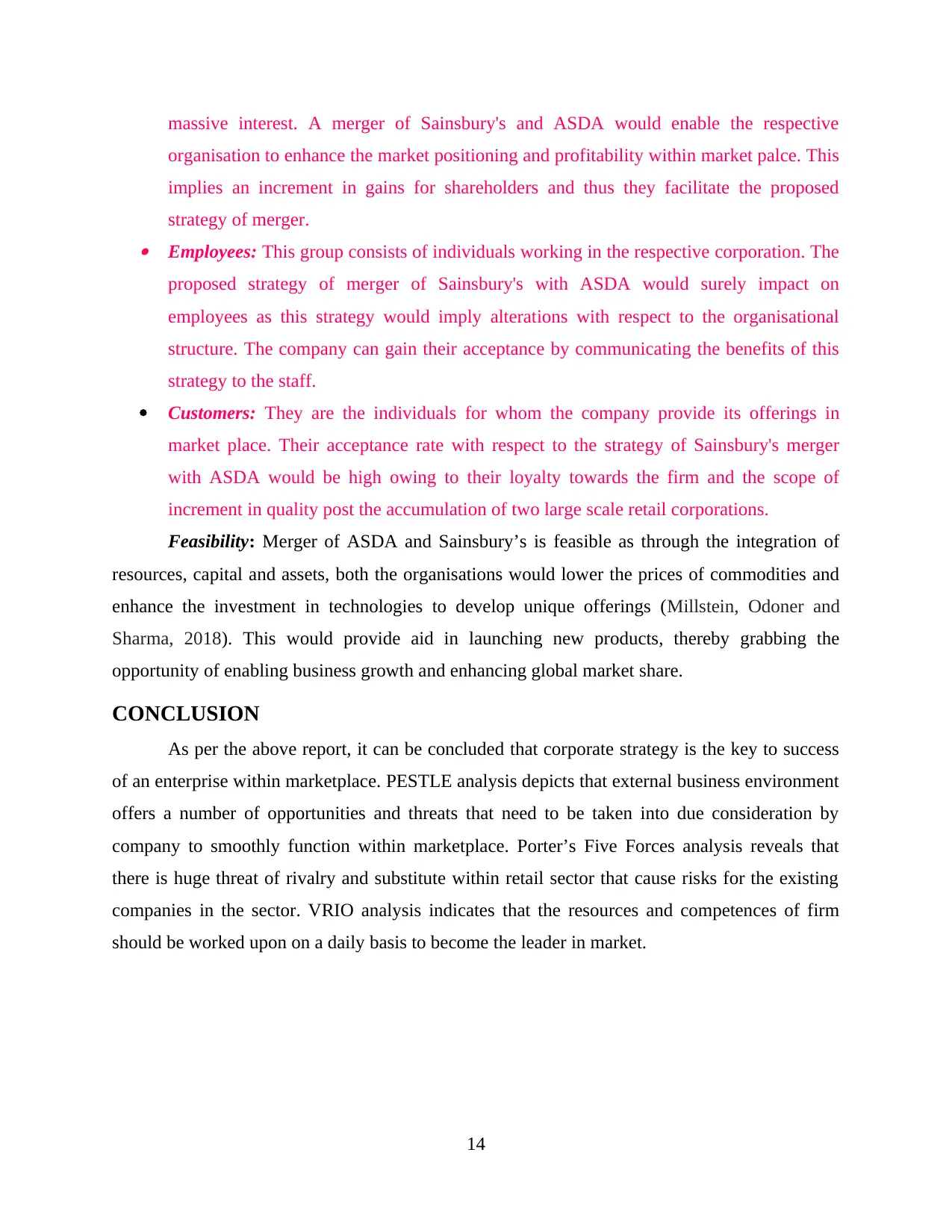
massive interest. A merger of Sainsbury's and ASDA would enable the respective
organisation to enhance the market positioning and profitability within market palce. This
implies an increment in gains for shareholders and thus they facilitate the proposed
strategy of merger. Employees: This group consists of individuals working in the respective corporation. The
proposed strategy of merger of Sainsbury's with ASDA would surely impact on
employees as this strategy would imply alterations with respect to the organisational
structure. The company can gain their acceptance by communicating the benefits of this
strategy to the staff.
Customers: They are the individuals for whom the company provide its offerings in
market place. Their acceptance rate with respect to the strategy of Sainsbury's merger
with ASDA would be high owing to their loyalty towards the firm and the scope of
increment in quality post the accumulation of two large scale retail corporations.
Feasibility: Merger of ASDA and Sainsbury’s is feasible as through the integration of
resources, capital and assets, both the organisations would lower the prices of commodities and
enhance the investment in technologies to develop unique offerings (Millstein, Odoner and
Sharma, 2018). This would provide aid in launching new products, thereby grabbing the
opportunity of enabling business growth and enhancing global market share.
CONCLUSION
As per the above report, it can be concluded that corporate strategy is the key to success
of an enterprise within marketplace. PESTLE analysis depicts that external business environment
offers a number of opportunities and threats that need to be taken into due consideration by
company to smoothly function within marketplace. Porter’s Five Forces analysis reveals that
there is huge threat of rivalry and substitute within retail sector that cause risks for the existing
companies in the sector. VRIO analysis indicates that the resources and competences of firm
should be worked upon on a daily basis to become the leader in market.
14
organisation to enhance the market positioning and profitability within market palce. This
implies an increment in gains for shareholders and thus they facilitate the proposed
strategy of merger. Employees: This group consists of individuals working in the respective corporation. The
proposed strategy of merger of Sainsbury's with ASDA would surely impact on
employees as this strategy would imply alterations with respect to the organisational
structure. The company can gain their acceptance by communicating the benefits of this
strategy to the staff.
Customers: They are the individuals for whom the company provide its offerings in
market place. Their acceptance rate with respect to the strategy of Sainsbury's merger
with ASDA would be high owing to their loyalty towards the firm and the scope of
increment in quality post the accumulation of two large scale retail corporations.
Feasibility: Merger of ASDA and Sainsbury’s is feasible as through the integration of
resources, capital and assets, both the organisations would lower the prices of commodities and
enhance the investment in technologies to develop unique offerings (Millstein, Odoner and
Sharma, 2018). This would provide aid in launching new products, thereby grabbing the
opportunity of enabling business growth and enhancing global market share.
CONCLUSION
As per the above report, it can be concluded that corporate strategy is the key to success
of an enterprise within marketplace. PESTLE analysis depicts that external business environment
offers a number of opportunities and threats that need to be taken into due consideration by
company to smoothly function within marketplace. Porter’s Five Forces analysis reveals that
there is huge threat of rivalry and substitute within retail sector that cause risks for the existing
companies in the sector. VRIO analysis indicates that the resources and competences of firm
should be worked upon on a daily basis to become the leader in market.
14
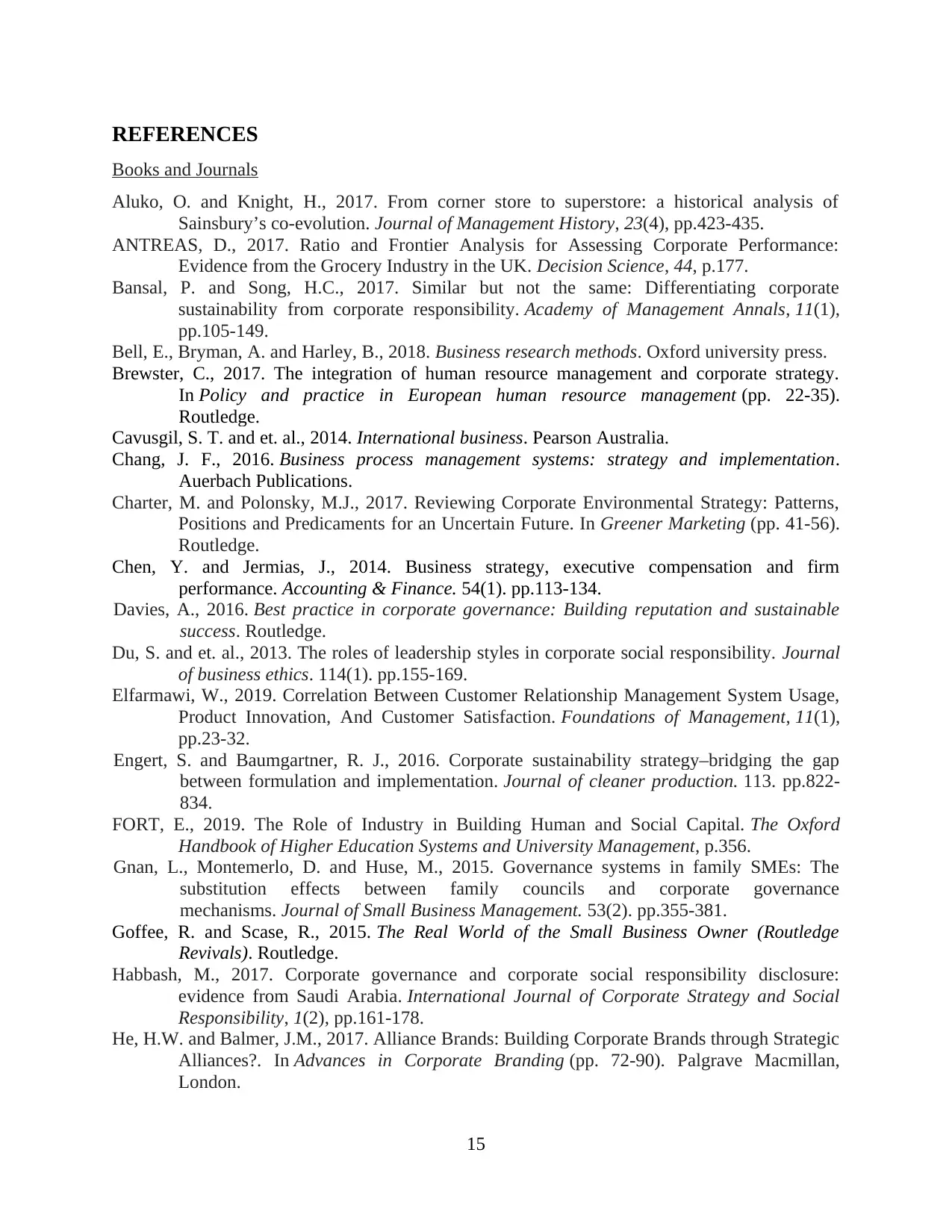
REFERENCES
Books and Journals
Aluko, O. and Knight, H., 2017. From corner store to superstore: a historical analysis of
Sainsbury’s co-evolution. Journal of Management History, 23(4), pp.423-435.
ANTREAS, D., 2017. Ratio and Frontier Analysis for Assessing Corporate Performance:
Evidence from the Grocery Industry in the UK. Decision Science, 44, p.177.
Bansal, P. and Song, H.C., 2017. Similar but not the same: Differentiating corporate
sustainability from corporate responsibility. Academy of Management Annals, 11(1),
pp.105-149.
Bell, E., Bryman, A. and Harley, B., 2018. Business research methods. Oxford university press.
Brewster, C., 2017. The integration of human resource management and corporate strategy.
In Policy and practice in European human resource management (pp. 22-35).
Routledge.
Cavusgil, S. T. and et. al., 2014. International business. Pearson Australia.
Chang, J. F., 2016. Business process management systems: strategy and implementation.
Auerbach Publications.
Charter, M. and Polonsky, M.J., 2017. Reviewing Corporate Environmental Strategy: Patterns,
Positions and Predicaments for an Uncertain Future. In Greener Marketing (pp. 41-56).
Routledge.
Chen, Y. and Jermias, J., 2014. Business strategy, executive compensation and firm
performance. Accounting & Finance. 54(1). pp.113-134.
Davies, A., 2016. Best practice in corporate governance: Building reputation and sustainable
success. Routledge.
Du, S. and et. al., 2013. The roles of leadership styles in corporate social responsibility. Journal
of business ethics. 114(1). pp.155-169.
Elfarmawi, W., 2019. Correlation Between Customer Relationship Management System Usage,
Product Innovation, And Customer Satisfaction. Foundations of Management, 11(1),
pp.23-32.
Engert, S. and Baumgartner, R. J., 2016. Corporate sustainability strategy–bridging the gap
between formulation and implementation. Journal of cleaner production. 113. pp.822-
834.
FORT, E., 2019. The Role of Industry in Building Human and Social Capital. The Oxford
Handbook of Higher Education Systems and University Management, p.356.
Gnan, L., Montemerlo, D. and Huse, M., 2015. Governance systems in family SMEs: The
substitution effects between family councils and corporate governance
mechanisms. Journal of Small Business Management. 53(2). pp.355-381.
Goffee, R. and Scase, R., 2015. The Real World of the Small Business Owner (Routledge
Revivals). Routledge.
Habbash, M., 2017. Corporate governance and corporate social responsibility disclosure:
evidence from Saudi Arabia. International Journal of Corporate Strategy and Social
Responsibility, 1(2), pp.161-178.
He, H.W. and Balmer, J.M., 2017. Alliance Brands: Building Corporate Brands through Strategic
Alliances?. In Advances in Corporate Branding (pp. 72-90). Palgrave Macmillan,
London.
15
Books and Journals
Aluko, O. and Knight, H., 2017. From corner store to superstore: a historical analysis of
Sainsbury’s co-evolution. Journal of Management History, 23(4), pp.423-435.
ANTREAS, D., 2017. Ratio and Frontier Analysis for Assessing Corporate Performance:
Evidence from the Grocery Industry in the UK. Decision Science, 44, p.177.
Bansal, P. and Song, H.C., 2017. Similar but not the same: Differentiating corporate
sustainability from corporate responsibility. Academy of Management Annals, 11(1),
pp.105-149.
Bell, E., Bryman, A. and Harley, B., 2018. Business research methods. Oxford university press.
Brewster, C., 2017. The integration of human resource management and corporate strategy.
In Policy and practice in European human resource management (pp. 22-35).
Routledge.
Cavusgil, S. T. and et. al., 2014. International business. Pearson Australia.
Chang, J. F., 2016. Business process management systems: strategy and implementation.
Auerbach Publications.
Charter, M. and Polonsky, M.J., 2017. Reviewing Corporate Environmental Strategy: Patterns,
Positions and Predicaments for an Uncertain Future. In Greener Marketing (pp. 41-56).
Routledge.
Chen, Y. and Jermias, J., 2014. Business strategy, executive compensation and firm
performance. Accounting & Finance. 54(1). pp.113-134.
Davies, A., 2016. Best practice in corporate governance: Building reputation and sustainable
success. Routledge.
Du, S. and et. al., 2013. The roles of leadership styles in corporate social responsibility. Journal
of business ethics. 114(1). pp.155-169.
Elfarmawi, W., 2019. Correlation Between Customer Relationship Management System Usage,
Product Innovation, And Customer Satisfaction. Foundations of Management, 11(1),
pp.23-32.
Engert, S. and Baumgartner, R. J., 2016. Corporate sustainability strategy–bridging the gap
between formulation and implementation. Journal of cleaner production. 113. pp.822-
834.
FORT, E., 2019. The Role of Industry in Building Human and Social Capital. The Oxford
Handbook of Higher Education Systems and University Management, p.356.
Gnan, L., Montemerlo, D. and Huse, M., 2015. Governance systems in family SMEs: The
substitution effects between family councils and corporate governance
mechanisms. Journal of Small Business Management. 53(2). pp.355-381.
Goffee, R. and Scase, R., 2015. The Real World of the Small Business Owner (Routledge
Revivals). Routledge.
Habbash, M., 2017. Corporate governance and corporate social responsibility disclosure:
evidence from Saudi Arabia. International Journal of Corporate Strategy and Social
Responsibility, 1(2), pp.161-178.
He, H.W. and Balmer, J.M., 2017. Alliance Brands: Building Corporate Brands through Strategic
Alliances?. In Advances in Corporate Branding (pp. 72-90). Palgrave Macmillan,
London.
15
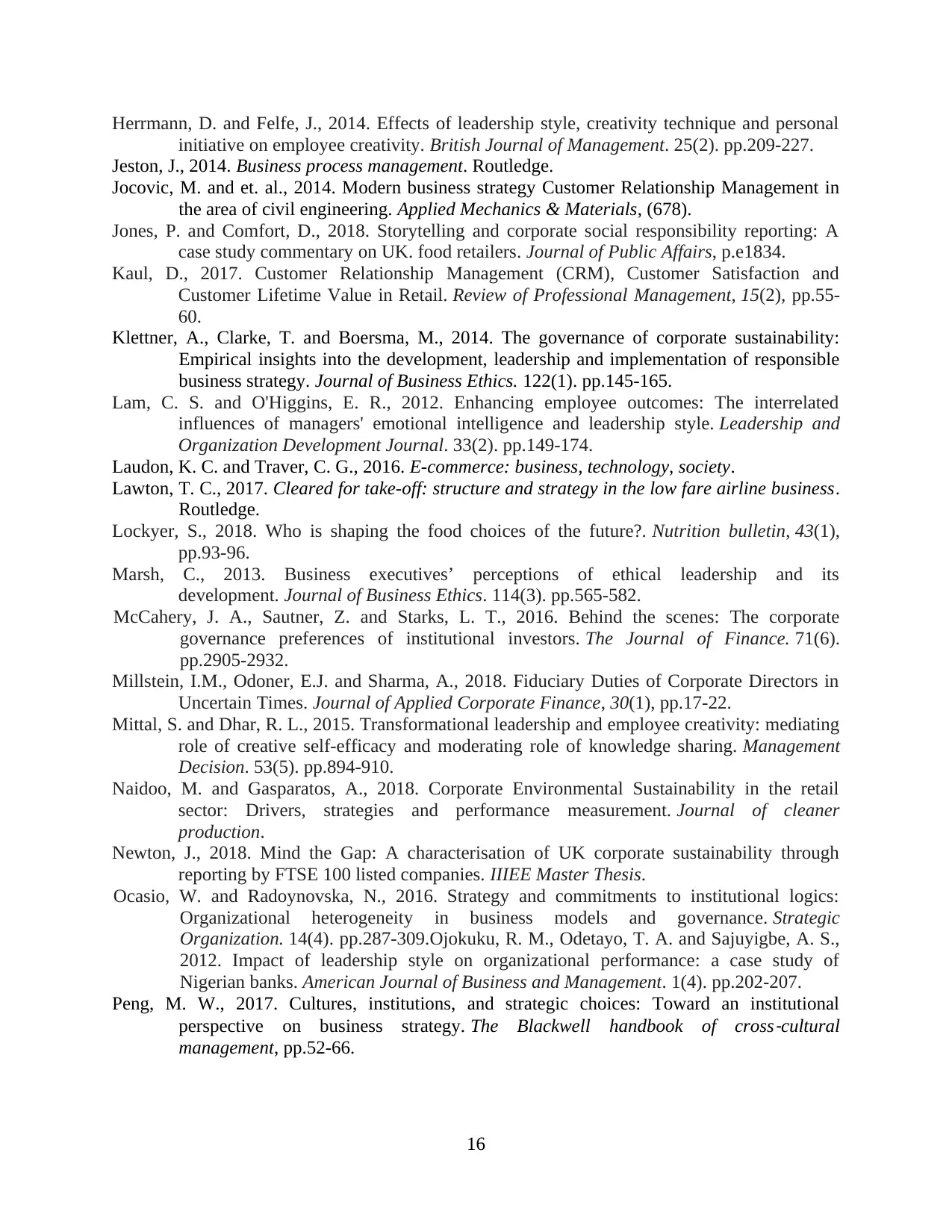
Herrmann, D. and Felfe, J., 2014. Effects of leadership style, creativity technique and personal
initiative on employee creativity. British Journal of Management. 25(2). pp.209-227.
Jeston, J., 2014. Business process management. Routledge.
Jocovic, M. and et. al., 2014. Modern business strategy Customer Relationship Management in
the area of civil engineering. Applied Mechanics & Materials, (678).
Jones, P. and Comfort, D., 2018. Storytelling and corporate social responsibility reporting: A
case study commentary on UK. food retailers. Journal of Public Affairs, p.e1834.
Kaul, D., 2017. Customer Relationship Management (CRM), Customer Satisfaction and
Customer Lifetime Value in Retail. Review of Professional Management, 15(2), pp.55-
60.
Klettner, A., Clarke, T. and Boersma, M., 2014. The governance of corporate sustainability:
Empirical insights into the development, leadership and implementation of responsible
business strategy. Journal of Business Ethics. 122(1). pp.145-165.
Lam, C. S. and O'Higgins, E. R., 2012. Enhancing employee outcomes: The interrelated
influences of managers' emotional intelligence and leadership style. Leadership and
Organization Development Journal. 33(2). pp.149-174.
Laudon, K. C. and Traver, C. G., 2016. E-commerce: business, technology, society.
Lawton, T. C., 2017. Cleared for take-off: structure and strategy in the low fare airline business.
Routledge.
Lockyer, S., 2018. Who is shaping the food choices of the future?. Nutrition bulletin, 43(1),
pp.93-96.
Marsh, C., 2013. Business executives’ perceptions of ethical leadership and its
development. Journal of Business Ethics. 114(3). pp.565-582.
McCahery, J. A., Sautner, Z. and Starks, L. T., 2016. Behind the scenes: The corporate
governance preferences of institutional investors. The Journal of Finance. 71(6).
pp.2905-2932.
Millstein, I.M., Odoner, E.J. and Sharma, A., 2018. Fiduciary Duties of Corporate Directors in
Uncertain Times. Journal of Applied Corporate Finance, 30(1), pp.17-22.
Mittal, S. and Dhar, R. L., 2015. Transformational leadership and employee creativity: mediating
role of creative self-efficacy and moderating role of knowledge sharing. Management
Decision. 53(5). pp.894-910.
Naidoo, M. and Gasparatos, A., 2018. Corporate Environmental Sustainability in the retail
sector: Drivers, strategies and performance measurement. Journal of cleaner
production.
Newton, J., 2018. Mind the Gap: A characterisation of UK corporate sustainability through
reporting by FTSE 100 listed companies. IIIEE Master Thesis.
Ocasio, W. and Radoynovska, N., 2016. Strategy and commitments to institutional logics:
Organizational heterogeneity in business models and governance. Strategic
Organization. 14(4). pp.287-309.Ojokuku, R. M., Odetayo, T. A. and Sajuyigbe, A. S.,
2012. Impact of leadership style on organizational performance: a case study of
Nigerian banks. American Journal of Business and Management. 1(4). pp.202-207.
Peng, M. W., 2017. Cultures, institutions, and strategic choices: Toward an institutional
perspective on business strategy. The Blackwell handbook of cross
‐cultural
management, pp.52-66.
16
initiative on employee creativity. British Journal of Management. 25(2). pp.209-227.
Jeston, J., 2014. Business process management. Routledge.
Jocovic, M. and et. al., 2014. Modern business strategy Customer Relationship Management in
the area of civil engineering. Applied Mechanics & Materials, (678).
Jones, P. and Comfort, D., 2018. Storytelling and corporate social responsibility reporting: A
case study commentary on UK. food retailers. Journal of Public Affairs, p.e1834.
Kaul, D., 2017. Customer Relationship Management (CRM), Customer Satisfaction and
Customer Lifetime Value in Retail. Review of Professional Management, 15(2), pp.55-
60.
Klettner, A., Clarke, T. and Boersma, M., 2014. The governance of corporate sustainability:
Empirical insights into the development, leadership and implementation of responsible
business strategy. Journal of Business Ethics. 122(1). pp.145-165.
Lam, C. S. and O'Higgins, E. R., 2012. Enhancing employee outcomes: The interrelated
influences of managers' emotional intelligence and leadership style. Leadership and
Organization Development Journal. 33(2). pp.149-174.
Laudon, K. C. and Traver, C. G., 2016. E-commerce: business, technology, society.
Lawton, T. C., 2017. Cleared for take-off: structure and strategy in the low fare airline business.
Routledge.
Lockyer, S., 2018. Who is shaping the food choices of the future?. Nutrition bulletin, 43(1),
pp.93-96.
Marsh, C., 2013. Business executives’ perceptions of ethical leadership and its
development. Journal of Business Ethics. 114(3). pp.565-582.
McCahery, J. A., Sautner, Z. and Starks, L. T., 2016. Behind the scenes: The corporate
governance preferences of institutional investors. The Journal of Finance. 71(6).
pp.2905-2932.
Millstein, I.M., Odoner, E.J. and Sharma, A., 2018. Fiduciary Duties of Corporate Directors in
Uncertain Times. Journal of Applied Corporate Finance, 30(1), pp.17-22.
Mittal, S. and Dhar, R. L., 2015. Transformational leadership and employee creativity: mediating
role of creative self-efficacy and moderating role of knowledge sharing. Management
Decision. 53(5). pp.894-910.
Naidoo, M. and Gasparatos, A., 2018. Corporate Environmental Sustainability in the retail
sector: Drivers, strategies and performance measurement. Journal of cleaner
production.
Newton, J., 2018. Mind the Gap: A characterisation of UK corporate sustainability through
reporting by FTSE 100 listed companies. IIIEE Master Thesis.
Ocasio, W. and Radoynovska, N., 2016. Strategy and commitments to institutional logics:
Organizational heterogeneity in business models and governance. Strategic
Organization. 14(4). pp.287-309.Ojokuku, R. M., Odetayo, T. A. and Sajuyigbe, A. S.,
2012. Impact of leadership style on organizational performance: a case study of
Nigerian banks. American Journal of Business and Management. 1(4). pp.202-207.
Peng, M. W., 2017. Cultures, institutions, and strategic choices: Toward an institutional
perspective on business strategy. The Blackwell handbook of cross
‐cultural
management, pp.52-66.
16
Secure Best Marks with AI Grader
Need help grading? Try our AI Grader for instant feedback on your assignments.
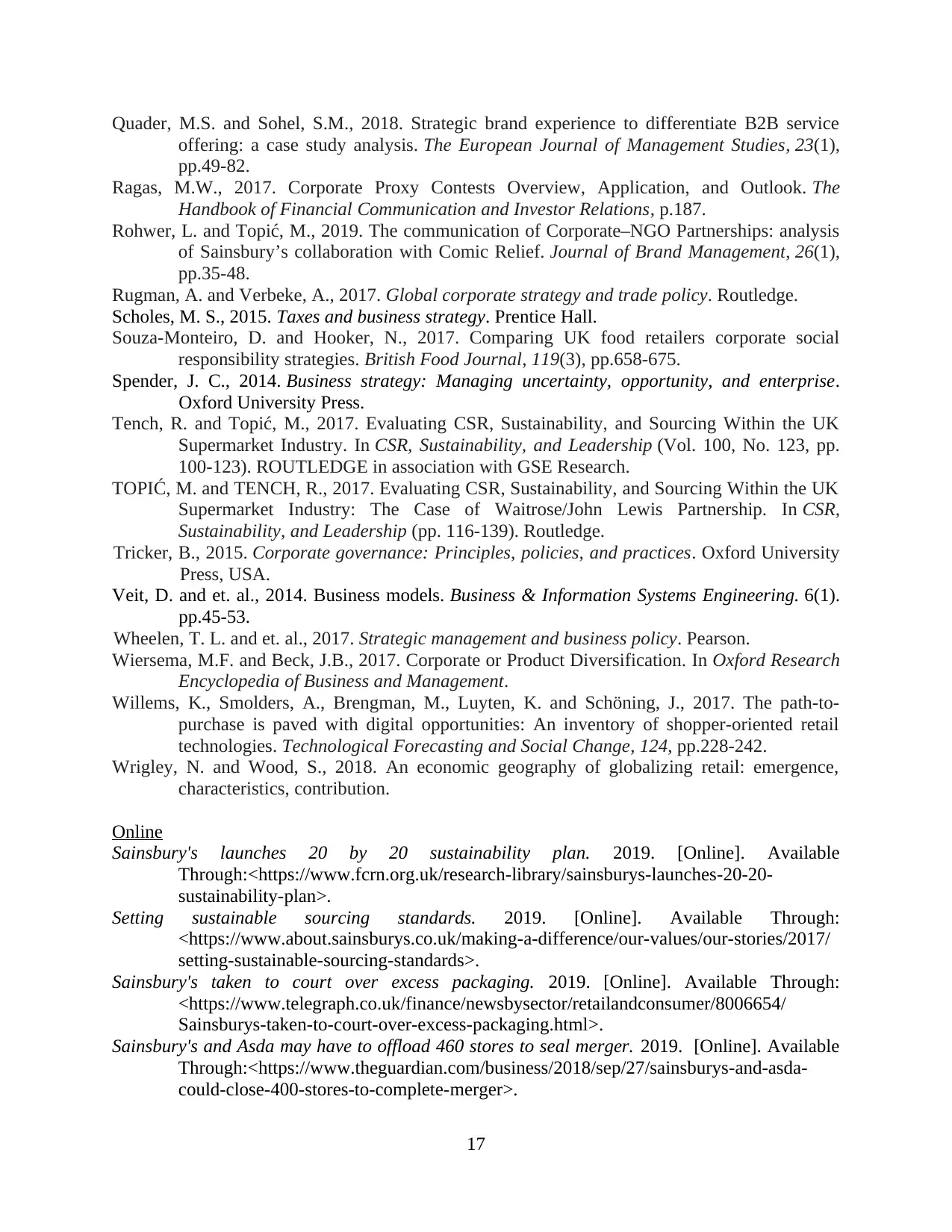
Quader, M.S. and Sohel, S.M., 2018. Strategic brand experience to differentiate B2B service
offering: a case study analysis. The European Journal of Management Studies, 23(1),
pp.49-82.
Ragas, M.W., 2017. Corporate Proxy Contests Overview, Application, and Outlook. The
Handbook of Financial Communication and Investor Relations, p.187.
Rohwer, L. and Topić, M., 2019. The communication of Corporate–NGO Partnerships: analysis
of Sainsbury’s collaboration with Comic Relief. Journal of Brand Management, 26(1),
pp.35-48.
Rugman, A. and Verbeke, A., 2017. Global corporate strategy and trade policy. Routledge.
Scholes, M. S., 2015. Taxes and business strategy. Prentice Hall.
Souza-Monteiro, D. and Hooker, N., 2017. Comparing UK food retailers corporate social
responsibility strategies. British Food Journal, 119(3), pp.658-675.
Spender, J. C., 2014. Business strategy: Managing uncertainty, opportunity, and enterprise.
Oxford University Press.
Tench, R. and Topić, M., 2017. Evaluating CSR, Sustainability, and Sourcing Within the UK
Supermarket Industry. In CSR, Sustainability, and Leadership (Vol. 100, No. 123, pp.
100-123). ROUTLEDGE in association with GSE Research.
TOPIĆ, M. and TENCH, R., 2017. Evaluating CSR, Sustainability, and Sourcing Within the UK
Supermarket Industry: The Case of Waitrose/John Lewis Partnership. In CSR,
Sustainability, and Leadership (pp. 116-139). Routledge.
Tricker, B., 2015. Corporate governance: Principles, policies, and practices. Oxford University
Press, USA.
Veit, D. and et. al., 2014. Business models. Business & Information Systems Engineering. 6(1).
pp.45-53.
Wheelen, T. L. and et. al., 2017. Strategic management and business policy. Pearson.
Wiersema, M.F. and Beck, J.B., 2017. Corporate or Product Diversification. In Oxford Research
Encyclopedia of Business and Management.
Willems, K., Smolders, A., Brengman, M., Luyten, K. and Schöning, J., 2017. The path-to-
purchase is paved with digital opportunities: An inventory of shopper-oriented retail
technologies. Technological Forecasting and Social Change, 124, pp.228-242.
Wrigley, N. and Wood, S., 2018. An economic geography of globalizing retail: emergence,
characteristics, contribution.
Online
Sainsbury's launches 20 by 20 sustainability plan. 2019. [Online]. Available
Through:<https://www.fcrn.org.uk/research-library/sainsburys-launches-20-20-
sustainability-plan>.
Setting sustainable sourcing standards. 2019. [Online]. Available Through:
<https://www.about.sainsburys.co.uk/making-a-difference/our-values/our-stories/2017/
setting-sustainable-sourcing-standards>.
Sainsbury's taken to court over excess packaging. 2019. [Online]. Available Through:
<https://www.telegraph.co.uk/finance/newsbysector/retailandconsumer/8006654/
Sainsburys-taken-to-court-over-excess-packaging.html>.
Sainsbury's and Asda may have to offload 460 stores to seal merger. 2019. [Online]. Available
Through:<https://www.theguardian.com/business/2018/sep/27/sainsburys-and-asda-
could-close-400-stores-to-complete-merger>.
17
offering: a case study analysis. The European Journal of Management Studies, 23(1),
pp.49-82.
Ragas, M.W., 2017. Corporate Proxy Contests Overview, Application, and Outlook. The
Handbook of Financial Communication and Investor Relations, p.187.
Rohwer, L. and Topić, M., 2019. The communication of Corporate–NGO Partnerships: analysis
of Sainsbury’s collaboration with Comic Relief. Journal of Brand Management, 26(1),
pp.35-48.
Rugman, A. and Verbeke, A., 2017. Global corporate strategy and trade policy. Routledge.
Scholes, M. S., 2015. Taxes and business strategy. Prentice Hall.
Souza-Monteiro, D. and Hooker, N., 2017. Comparing UK food retailers corporate social
responsibility strategies. British Food Journal, 119(3), pp.658-675.
Spender, J. C., 2014. Business strategy: Managing uncertainty, opportunity, and enterprise.
Oxford University Press.
Tench, R. and Topić, M., 2017. Evaluating CSR, Sustainability, and Sourcing Within the UK
Supermarket Industry. In CSR, Sustainability, and Leadership (Vol. 100, No. 123, pp.
100-123). ROUTLEDGE in association with GSE Research.
TOPIĆ, M. and TENCH, R., 2017. Evaluating CSR, Sustainability, and Sourcing Within the UK
Supermarket Industry: The Case of Waitrose/John Lewis Partnership. In CSR,
Sustainability, and Leadership (pp. 116-139). Routledge.
Tricker, B., 2015. Corporate governance: Principles, policies, and practices. Oxford University
Press, USA.
Veit, D. and et. al., 2014. Business models. Business & Information Systems Engineering. 6(1).
pp.45-53.
Wheelen, T. L. and et. al., 2017. Strategic management and business policy. Pearson.
Wiersema, M.F. and Beck, J.B., 2017. Corporate or Product Diversification. In Oxford Research
Encyclopedia of Business and Management.
Willems, K., Smolders, A., Brengman, M., Luyten, K. and Schöning, J., 2017. The path-to-
purchase is paved with digital opportunities: An inventory of shopper-oriented retail
technologies. Technological Forecasting and Social Change, 124, pp.228-242.
Wrigley, N. and Wood, S., 2018. An economic geography of globalizing retail: emergence,
characteristics, contribution.
Online
Sainsbury's launches 20 by 20 sustainability plan. 2019. [Online]. Available
Through:<https://www.fcrn.org.uk/research-library/sainsburys-launches-20-20-
sustainability-plan>.
Setting sustainable sourcing standards. 2019. [Online]. Available Through:
<https://www.about.sainsburys.co.uk/making-a-difference/our-values/our-stories/2017/
setting-sustainable-sourcing-standards>.
Sainsbury's taken to court over excess packaging. 2019. [Online]. Available Through:
<https://www.telegraph.co.uk/finance/newsbysector/retailandconsumer/8006654/
Sainsburys-taken-to-court-over-excess-packaging.html>.
Sainsbury's and Asda may have to offload 460 stores to seal merger. 2019. [Online]. Available
Through:<https://www.theguardian.com/business/2018/sep/27/sainsburys-and-asda-
could-close-400-stores-to-complete-merger>.
17
1 out of 17
Related Documents
Your All-in-One AI-Powered Toolkit for Academic Success.
+13062052269
info@desklib.com
Available 24*7 on WhatsApp / Email
![[object Object]](/_next/static/media/star-bottom.7253800d.svg)
Unlock your academic potential
© 2024 | Zucol Services PVT LTD | All rights reserved.





